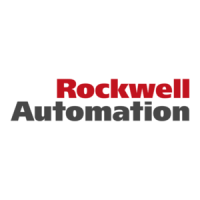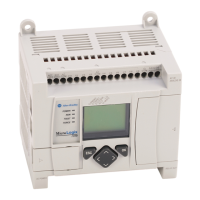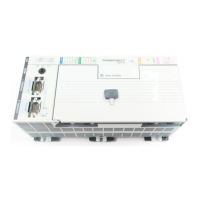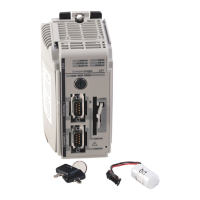Rockwell Automation Publication 1766-UM001O-EN-P - September 2021 17
Chapter 1 Hardware Overview
Communication Options The MicroLogix 1400 controllers provide three communications ports, an
isolated combination RS-232/485 communication port (Channel 0), an
Ethernet port (Channel 1) and a non-isolated RS-232 communication port
(Channel 2).
The Channel 0 and Channel 2 ports on the MicroLogix 1400 can be connected
to the following:
• operator interfaces, personal computers, and so on, using DF1 Full
Duplex point-to-point
•a DH-485 network
• a DF1 Radio Modem network
• a DF1 half-duplex network as an RTU Master or RTU Slave
• a Modbus network as an RTU Master or RTU Slave
• an ASCII network
• an Ethernet network using the Ethernet Interface module (catalog
number 1761-NET-ENI, or 1761-NET-ENIW)
• a DNP3 network as a Slave
When connecting to RS-485 network using DH-485, DF1 Half-Duplex Master/
Slave, Modbus RTU Master/Slave, or DNP3 Slave protocols, the MicroLogix
1400 can be connected directly via Channel 0 without an Advanced Interface
Converter, catalog number 1761-NET-AIC. The Channel 0 combo port provides
both RS-232 and RS-485 isolated connections. The appropriate electrical
interface is selected through your choice of communication cable. The existing
MicroLogix 1761 communication cables provide an interface to the RS-232
drivers. The 1763-NC01 cable provides an interface to the RS-485 drivers.
The controller may also be connected to serial devices, such as bar code
readers, weigh scales, serial printers, and other intelligent devices, using
ASCII. See Default Communication Configuration
on page 58 for the
configuration settings for Channel 0. MicroLogix 1400 can be connected
directly to RS-485 network via channel 0, using ASCII.
The MicroLogix 1400 supports EtherNet/IP™ communication via the Ethernet
communication Channel 1. In addition, either Modbus TCP or DNP3 over IP
can be enabled for Channel 1. You can connect your controller to a local area
network that provides communication between various devices at 10 Mbps or
100 Mbps. This port supports CIP explicit messaging (message exchange) only.
The controller cannot be used for CIP implicit messaging (real-time I/O
messaging). The controller also includes an embedded web server which allows
viewing of not only module information, TCP/IP configuration, and diagnostic
information, but also includes the data table memory map and data table
monitor screen using a standard web browser.
See Chapter 4
for more information on connecting to the available
communication options.
1766-L32DWD B B FRN5 May 2007
• Initial Product release. Supports all the features listed above for the 1766-L32AWA,
1766-L32BWA, and 1766-L32BBB controllers.
(1) OS = Operating System.
Table 1 - MicroLogix 1400 (Continued)
Catalog Number
OS
(1)
Series
Letter
OS Revision
Letter
OS
Firmware
Release No.
Release Date Enhancement

